Amidst the bustling symphony of nature, a group of arboreal wonders silently stands out – trees that start with A! These arboreal giants, with their unique characteristics and contributions to our environment, deserve a closer look. Let’s start with a few of the most beloved and well-known trees that start with A!
1. Arborvitae
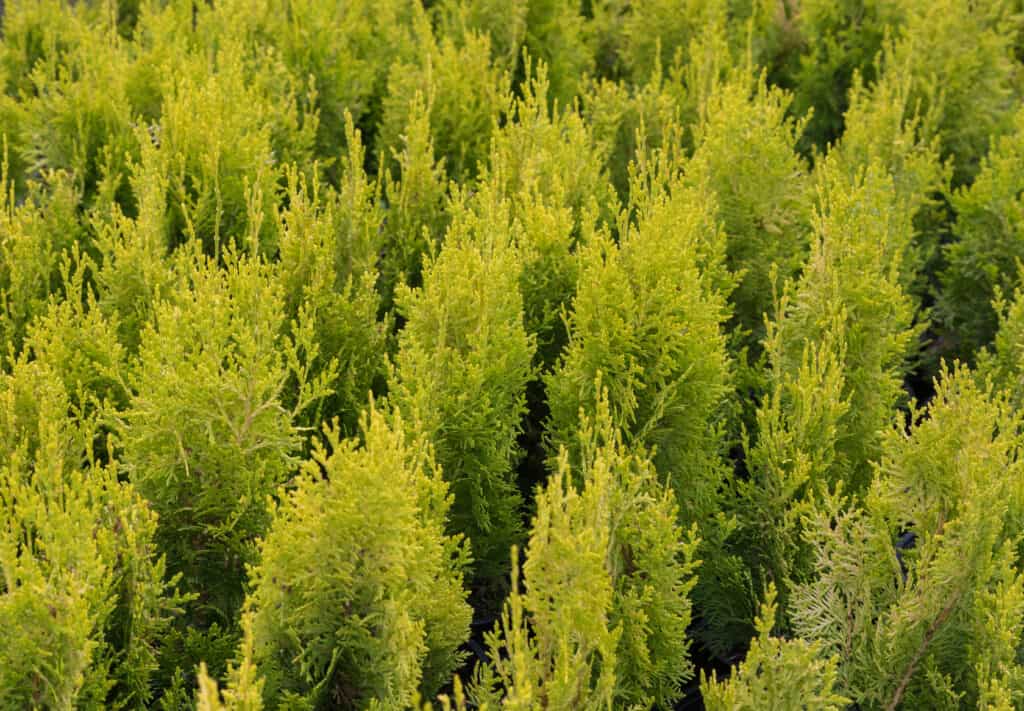
Most arborvitae species and varieties are hardy in zones 3 through 8.
©Deyana Stefanova Robova/Shutterstock.com
Arborvitae trees, also known as Thuja, are one of many trees that start with A renowned for their impressive height. They typically range from 10 to 70 feet, depending on the species and environmental conditions. These evergreen conifers have long been valued for their multifaceted benefits and diverse applications.
One of the primary advantages of arborvitae trees lies in their ornamental and practical uses. Due to their towering stature and dense foliage, they are commonly employed as natural privacy screens and windbreaks. Homeowners and landscapers often plant them along property boundaries to create a shield from prying eyes and strong winds. Their elegant, pyramid-shaped growth habit lends a timeless appeal to gardens and landscapes.
Arborvitae trees are not only visually appealing but also ecologically important. Carbon dioxide is removed from the air and replaced with oxygen by these plants, making a positive impact on climate change and air quality. Also, many kinds of animals, such as birds and small mammals, rely on their protective canopies for survival.
The utility of arborvitae extends beyond aesthetics and environmental benefits. Their wood possesses valuable qualities that make it a preferred choice for a range of applications. Arborvitae wood is lightweight, durable, and naturally resistant to decay and insects. Consequently, it is frequently used in crafting outdoor furniture, fences, and even small watercraft.
Also, arborvitae trees have a history of medicinal use. Some indigenous cultures have utilized their leaves and bark for their potential therapeutic properties, such as treating certain ailments and skin conditions.
2. Alder
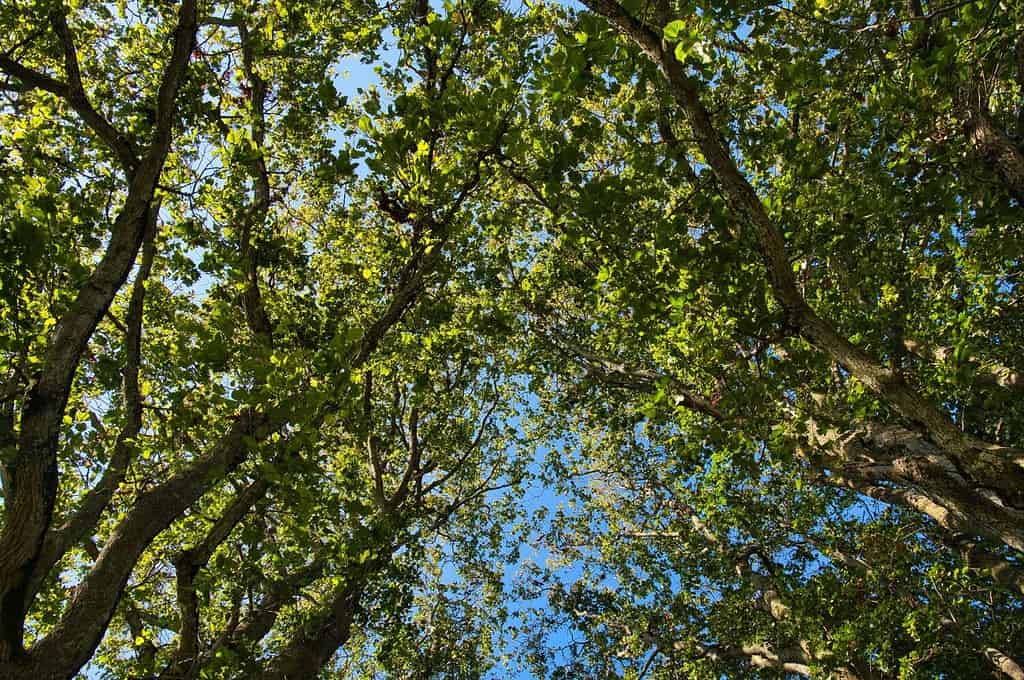
Most alder tree species, such as the white alder (pictured) are not very hardy and tend to only do well in hardiness zones 5 through 10.
©Wirestock Creators/Shutterstock.com
The genus Alnus, more often known as the genus of alder trees, has a wide variety of deciduous shrubs and trees that start with A and are native to many parts of the world. They normally reach heights of 20 to 50 feet. However, some species can grow much bigger than that. These useful trees provide several benefits.
One of the notable benefits of alder trees is their ability to enrich the soil through a process called nitrogen fixation. Alders have specialized root nodules that host nitrogen-fixing bacteria, which convert atmospheric nitrogen into a form that plants can use. This enriches the soil with essential nutrients, making it more fertile and beneficial for neighboring plants.
Alders also play a vital role in stabilizing riverbanks and preventing soil erosion. Their robust root systems help anchor the soil along riverbanks, reducing the risk of erosion during heavy rains and floods. This ecological service aids in maintaining water quality and protecting aquatic habitats.
Furthermore, alder wood has a variety of practical applications. It is lightweight, easy to work with, and known for its durability when submerged in water. These qualities make it a preferred choice for crafting items like boats, furniture, and musical instruments. Alder is also used as firewood, thanks to its moderate heat output and relatively low smoke production.
In addition to their ecological and utilitarian roles, alder trees provide habitat and sustenance for wildlife. Their catkins (long, slender flowering spikes) provide a source of food for birds, insects, and small mammals. The shelter provided by the trees also offers nesting sites and refuge for various bird species.
3. Ash
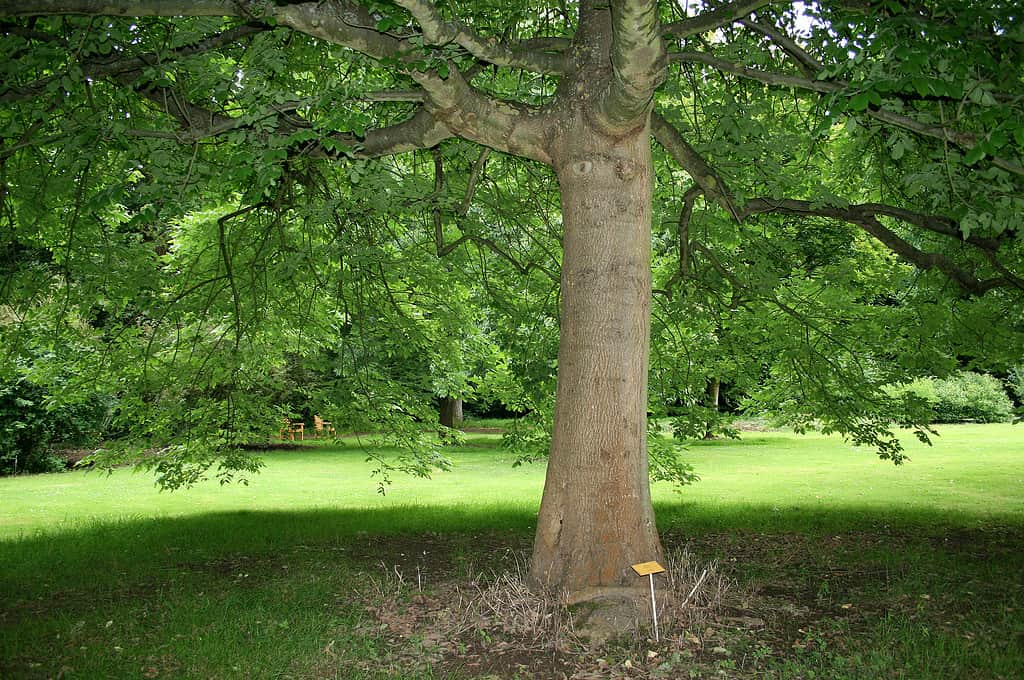
Most ash species such as the Oregon Ash or
Fraxinus latifolia(pictured) can survive quite well in colder regions such as hardiness zone 2 through zone 9.
Ash trees, belonging to the Fraxinus genus, are a group of deciduous trees that start with A and are known for their distinctive features, wide distribution, and various benefits. These trees typically reach heights of 50 to 80 feet, with some species growing even taller.
One of the notable benefits of ash trees is their timber. Ashwood is renowned for its strength, flexibility, and straight grain, making it a valuable resource for crafting a wide range of products. It is often used in furniture making, flooring, tool handles, and sports equipment such as baseball bats.
Ash trees also provide several ecological advantages. Their dense canopies offer shade and habitat for numerous wildlife species. Birds, squirrels, and insects find shelter among the branches and leaves, contributing to biodiversity.
Moreover, ash trees have cultural significance in various societies. In Norse mythology, the ash tree, known as Yggdrasil, symbolizes the cosmic tree of life and knowledge. It holds a revered place in many cultures for its symbolism of strength, resilience, and growth.
However, ash trees face a significant threat from the emerald ash borer (Agrilus planipennis), an invasive beetle species that has devastated ash populations in North America. The emerald ash borer larvae tunnel beneath the bark, disrupting nutrient flow and ultimately leading to the tree’s decline.
Despite this challenge, efforts are being made to combat the emerald ash borer and preserve ash tree populations. These efforts include the development of insect-resistant varieties and the removal and replacement of infected trees.
4. Aspen
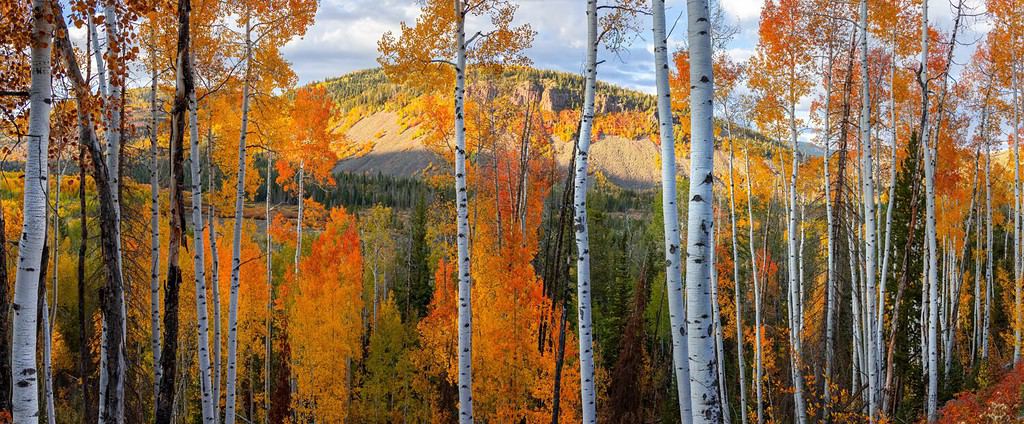
Aspen trees grow well in cold hardiness zones, usually in zones 2 through 8. However, despite their cold hardiness, they do need full sun to thrive.
©SNEHIT PHOTO/Shutterstock.com
Aspen trees, scientifically known as Populus tremuloides, are remarkable deciduous trees that start with A found across North America. They are known for their unique features, moderate height, and versatile uses, making them a distinctive and valuable part of various ecosystems.
Aspen trees typically reach heights of 40 to 50 feet, although some individuals can grow even taller. What sets aspens apart is their distinctive leaves, which have a flattened stem that causes them to flutter and quiver in the slightest breeze.
One of the standout features of aspen trees is their interconnected root systems. Unlike many other trees, aspens often grow in vast stands known as “clonal groves” because they originate from a single-parent tree connected by a network of underground roots. This means that many trees in an aspen grove are genetically identical and share the same root system. This interconnected root system allows them to reproduce quickly and effectively colonize new areas.
Aspen wood is prized for its versatility and strength. Paper, timber, and furniture production all depend heavily on it. The wood’s light hue and fine texture make it a desirable material for a wide range of indoor and outdoor uses. Because of its malleability, it can also be used to produce things like wooden utensils and ornaments.
In addition to their practical uses, aspen groves provide important habitat and sustenance for wildlife. They offer shelter and nesting sites for birds and small mammals. The young shoots of aspen trees are a preferred food source for various herbivores like deer and elk.
5. Acacia
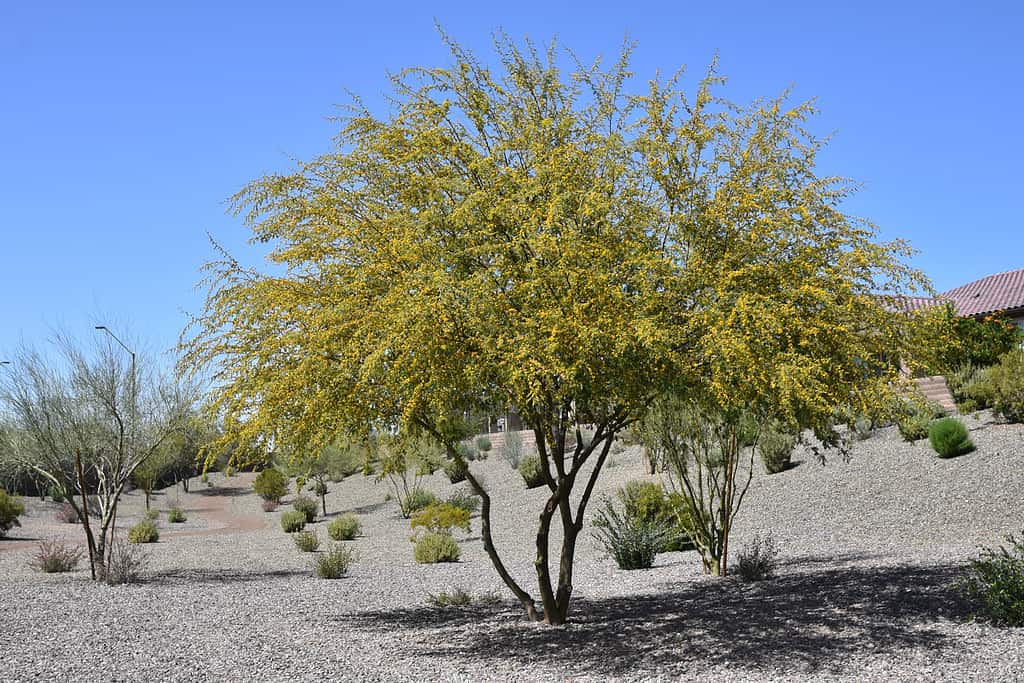
The heat-loving Acacia tree is hardy in zones 9, 10, and 11.
©Thomas Trompeter/Shutterstock.com
Acacia trees, which belong to the Fabaceae family, are well-known for their unique traits, many practical applications, and ecological value. Their stature can vary widely, from that of a shrub to that of a tree 100 feet or more in height.
One of the defining features that sets these trees that start with A apart is their unique foliage. Many species exhibit feathery, finely divided leaves, often adapted to conserve water in arid environments. The distinctive, often bright yellow flowers of acacia trees make them stand out in their surroundings. These vibrant blooms attract pollinators like bees and birds, contributing to local ecosystems.
Acacia trees are valued for their versatility and wide range of practical uses. The wood of certain acacia species is highly durable, making it suitable for various construction and woodworking purposes. It finds widespread use, from home furnishings to musical instruments. Just as well, certain acacia species include tannins in their bark that have historically been used in the tanning of leather.
Beyond their practical applications, acacia trees hold ecological importance. They play an important role in their ecosystems by giving shelter and food to a wide variety of animals. Many insects and herbivores feast on the blooms and leaves of this tree, and the thick canopy protects birds and small animals. The deep root systems of acacia trees are utilized in erosion control in some places.
Furthermore, acacia trees have cultural significance in different societies. They have been revered in various cultures for their symbolism, often representing endurance, resilience, and adaptability. Acacia wood is sometimes used in religious rituals and ceremonies.
6. Apple

Most apple tree varieties grow well in zones 3, 4, and 5.
©Scott Stephens/Shutterstock.com
Apple trees, scientifically known as Malus domestica, are iconic fruit-bearing trees cherished for their moderate height, culinary versatility, and cultural significance. The height of these deciduous trees is normally between 10 and 30 feet. However, this might vary with species and environment.
Apple trees are special since they are responsible for producing apples, one of the most popular fruits in the world. Apples may be used in a broad variety of dishes because of their varied colors, tastes, and textures. From crisp, sweet varieties perfect for snacking to tart apples ideal for pies and sauces, their versatility in the kitchen is unmatched. This adaptability has made them a staple in households and cuisines worldwide.
Apple trees are not only valued for their fruit but also for their striking blossoms. In the spring, apple trees burst into a profusion of delicate and fragrant flowers, creating picturesque landscapes. These blossoms attract pollinators like bees, aiding in the fertilization process that leads to the production of apples.
Beyond their culinary and ornamental attributes, apple trees hold cultural and historical significance. They’ve been farmed for centuries, with early advocates coming from the Greeks and Romans. In folklore, mythology, and religion, apples frequently represent wisdom, temptation, and abundance.
Also, apple wood is utilized for various purposes, although it is not as well-known as the fruit. It is prized for its fine grain and pleasant aroma, making it suitable for crafting small wooden items such as tool handles, carvings, and even smoking meats.
7. Amur Maple
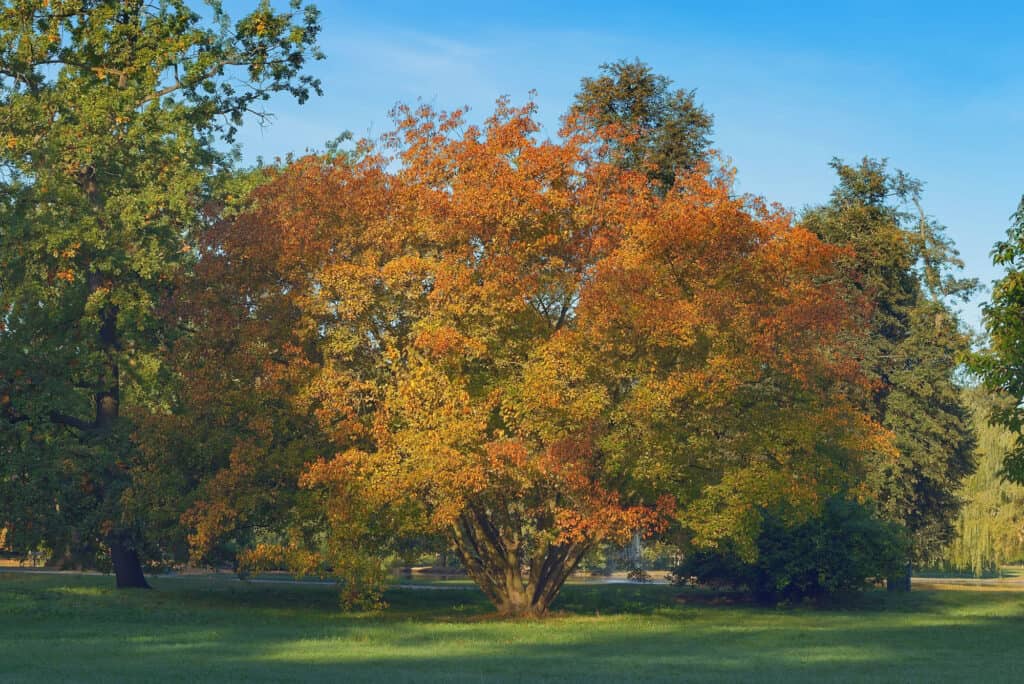
These maple trees grow well in zones 3 through 8.
©arazu/Shutterstock.com
Amur maple trees, scientifically known as Acer ginnala, are notable for their modest height, distinctive characteristics, and various benefits. These deciduous trees typically reach heights of 15 to 20 feet, making them smaller than many other tree species.
What sets Amur maple trees apart is their vibrant and ornamental qualities. In the fall, their leaves undergo a stunning transformation, turning brilliant shades of red, orange, and yellow. This autumnal display adds a burst of color to landscapes and makes them popular choices for ornamental planting in gardens and urban areas.
Amur maples offer several benefits, including their adaptability to different soil types and climates. Because of their resilience and adaptability, they may be planted in a wide range of environments. Due to their compact stature and lush canopies, they are frequently chosen for these functions in residential parks and gardens.
In addition to their visual appeal, Amur maples play a role in supporting wildlife. Birds are attracted to their seeds, which are borne in distinctive winged fruits known as samaras. These samaras serve as a food source for various bird species and contribute to local biodiversity.
Despite their relatively small stature, Amur maples have some practical uses. Their wood, although not widely utilized, is occasionally employed for crafting small wooden items like cutting boards, bowls, and tool handles. However, it is worth noting that their primary value lies in their aesthetic and ecological contributions.
8. Australian Pine

The elegant Australian pine tree is hardy in zones 3b through 7.
©Vijayakumar Bingi/iStock via Getty Images
Australian pine trees, scientifically known as Casuarina equisetifolia, are notable for their unique appearance, environmental adaptability, and practical uses. These evergreen conifers typically range in height from 30 to 100 feet, although some can grow even taller.
What sets Australian pine trees apart is their striking resemblance to pine trees despite not being true pines. They have needle-like foliage and cones, which are atypical for most tropical trees. This distinctive appearance has earned them the nickname “Australian pine” and makes them easily recognizable.
Australian pine trees offer several benefits. They are commonly used for coastal stabilization due to their strong root systems that help prevent erosion along shorelines. Their dense canopy provides shade, making them suitable choices for landscaping in warm coastal areas. Additionally, their wood is highly prized for its durability, making it a valuable resource for construction, particularly in regions prone to termite infestations.
Despite their practical applications, Australian pine trees are considered invasive in some regions, including parts of the United States and Hawaii. Their aggressive growth can outcompete native vegetation and disrupt local ecosystems. Invasive Australian pine removal efforts are underway in these areas to restore native habitats.
It’s also worth mentioning that the wood of Australian pine trees is used in various industries, particularly in regions where the species is abundant. It is employed in building materials, furniture, and paper production. The wood’s strength and resistance to termites make it a preferred choice in construction.
Summary of Trees That Start With A + More
| # | Tree |
|---|---|
| 1 | Arborvitae |
| 2 | Alder |
| 3 | Ash |
| 4 | Aspen |
| 5 | Acacia |
| 6 | Apple |
| 7 | Amur Maple |
| 8 | Australian Pine |
| 9 | American Holly |
| 10 | African Blackwood |
| 11 | African Baobab |
| 12 | Allspice |
| 13 | American Hornbeam |
| 14 | African Mahogany |
| 15 | American Sweetgum |
| 16 | Angophora |
| 17 | Apricot |
| 18 | Argan |
| 19 | Arrowwood Viburnum |
| 20 | Atlas Cedar |
| 21 | Azalea |
| 22 | Avocado |
| 23 | Autumn Blaze Maple |
| 24 | Austrian Pine |
| 25 | African Tulip Tree |
| 26 | African Olive |
| 27 | American Elm |
The photo featured at the top of this post is © HudsonValleyNY/Shutterstock.com
Thank you for reading! Have some feedback for us? Contact the AZ Animals editorial team.







